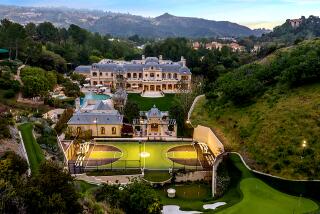THE BUYER IS BEWARING : With Designer Houses Selling for Half of What They Used to, Why Are We Not Rushing to Buy?
- Share via
I was at a Silver Lake barbecue last weekend, working on a third bottle of diet root beer, when somebody mentioned that a friend of hers--a novelist, and not the Sidney Sheldon kind--had just bought a Frank Lloyd Wright house whose price had been cut in half, a house as beautiful and serene as a museum. I found it comforting that a writer could afford such a splendid house without having to hustle Sharon Stone vehicles or books about slain debutantes. It seemed the stuff of a dream. Others were not so sanguine.
“How,” a friend asked, “is my puny house going to sell when a Frank Lloyd Wright costs only a few hundred thousand dollars more?” Somebody’s boyfriend mumbled that property is theft. A screenwriter pal, who had typed up a press release for the editor of the Hot Properties column before her new pad had even gone into escrow, implied that she probably wouldn’t be moving after all, that she liked her current house just fine.
It is in the canon learned by all Angelenos, right between earthquake-preparedness and the law of fine weather on New Year’s Day, that a house will always be worth more than you paid for it, that a kitchen swank enough to be featured in Met Home will be worth every cent you shelled out for the remodel. Potshots at the bourgeoisie are one thing; a real estate slump is a hard shot to the midsection of the California way of life.
When real estate prices started to drop a couple of years ago, a lot of people I know started to gloat: Some of the homeowners complaining had seen their house values rise from $40,000 to $450,000 and were miffed that the value had dropped to $375,000. People with more-legitimate beefs tended to be the kind of white-collar itinerants who had moved to town just a few years before and were moving on to Tucson or Seattle. Since it seemed inconceivable that any of us could ever afford--or would want to spend--the third-of-a-million dollars that it would cost to buy even a two-bedroom bungalow in the modest suburbs we had grown up in, the market correction was mostly irrelevant. They were the homeowners; we were the people with really boss record collections.
Near the end of the early-’80s recession, with all the arrogance of a college guy who’d just aced his Econ 3 midterm, I informed my house-hunting mom that prices on the Westside were going to have to come down soon, that the Los Angeles real estate market had matured. All she had to do was wait a little while for the right price. Hey, I read it in The Times. A decade later, still living in an unair-conditioned rental, she has almost forgiven me.
Each Sunday, I leaf through the Westside real estate supplement that is tucked into the classifieds; each Sunday, my wife gently pries the section from fingers gone rigid with anger.
Almost everybody my age I knew who actually owned a house had either married a hotshot litigator or bought a tiny cottage in a picturesque, though graffiti-splashed, quarter of the city, or had inherited or participated in some scam. I once interviewed a performance artist who told me how she’d managed to leverage the down payment for her Venice beach house from the proceeds of a student loan, and I was so flabbergasted that I actually paid attention to her two-hour monologue on an old boyfriend’s inner shaman. (I’d wasted my student loan on a bass amp the size of a refrigerator.)
Now, the Department of Housing and Urban Development blares jingles on the local disco station, advertising homes for $500 down as if these were the land rush days of the ‘20s. Exclusive gated communities bristle with for-sale signs. Frank Lloyd Wright houses are going for half price. Now that the price of a house seems almost within reach, we’re all too scared to buy. But at least we’re not insane.
“We’re moving to New York City,” a homeowner acquaintance said, “where a person can walk down the street without getting shot.”
Oh!
More to Read
Inside the business of entertainment
The Wide Shot brings you news, analysis and insights on everything from streaming wars to production — and what it all means for the future.
You may occasionally receive promotional content from the Los Angeles Times.











